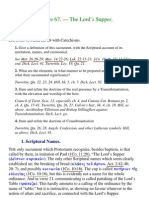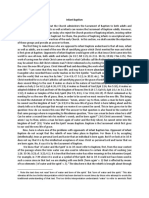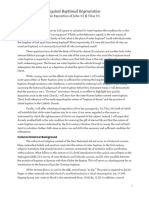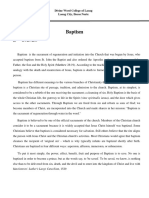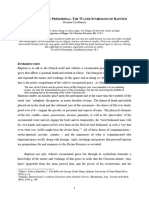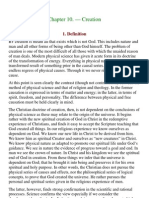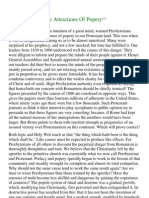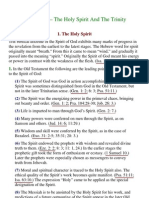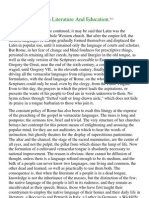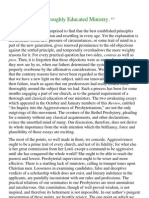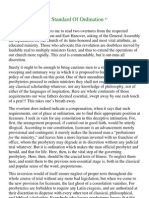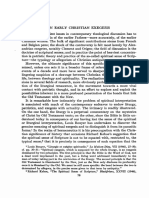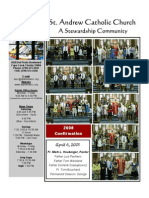Dab Lecture63
Dab Lecture63
Uploaded by
truthwarrior007Copyright:
Available Formats
Dab Lecture63
Dab Lecture63
Uploaded by
truthwarrior007Copyright
Available Formats
Share this document
Did you find this document useful?
Is this content inappropriate?
Copyright:
Available Formats
Dab Lecture63
Dab Lecture63
Uploaded by
truthwarrior007Copyright:
Available Formats
Lecture 63. Baptism.
Syllabus.
1. Is water Baptism, by Gods appointment, a permanent ordinance in the
Church?
Turrettin, Loc. 19, Qu. 12. Hill, bk. 5, ch. 6, 1, 2.
2. What are the signification and effects of Baptism? Consider the doctrine of
baptismal regeneration. Does Baptism represent, as Immersionists say, the
burial and resurrection of Christ?
Turrettin, Qu. 19, 1-16. Armstrong on Baptism, pt. 2, ch. 2, pt. 1, chs. 8, 9.
Dick, Lect. 89.
3. What formulary of words should accompany baptism? and what their
signification? Are any other formalities admissible? or sponsors?
Turrettin, Qu. 17. Dick. Lects. 88, 89. Knapp, 139.
4. Was J ohns Baptism the Christian sacrament of the new dispensation? For
what signification was Christ baptized by him?
Turrettin, Qu. 16. Armstrong, pt, 1, ch. 9. Dick, Lect. 88. Calvins Inst. bk. 4
ch. 15, 4 7, 18.
5. State the classic, and then the scriptural meanings of the words pot and
pot and their usage when applied in the Septuagint and New Testament
to Levitical washings.
Armstrong, pt. 1, chs. 3, 4, 5. Rice & Campbells Debate, Prop. 1. Dales
Classic Bap. Dales J udaic Bap. Carson on Bap.
6. Show that a change of meaning and mode takes place in the word pot,
in passing from a secular to a sacred use.
Armstrong, pt. 1, ch. 1, &c. On whole, Conf, of Faith, ch. 28.
1. Water Baptism Perpetual.
THE general remarks made concerning the sacraments, and applied to baptism,
will not be repeated. The earlier Socinians disputed the perpetual obligation of
water-baptism, as the Quakers now do of both the sacraments, and on similar
grounds. They plead that the new is intended to be a spiritual dispensation; that
salvation is always in the New Testament conditioned essentially on the state
of heart: that Paul (1Co. 1:17) says, Christ sent me not to baptize, but to
preach the gospel: and that the water-baptism administered by the apostles
was only a temporary badge to separate the Church from J ews and Pagans at
its outset. Quakers suppose that the only sacraments to be observed in our day
are those of the heart, the baptism of the Holy Ghost, and the feeding on Christ
by faith. The answers are: That the Old Testament, with its numerous types
and two sacraments, was also a spiritual dispensation, and saving benefits were
then, just as much as now, conditioned on the state of the heart; that the
commission to baptize men was evidently co-extensive with that to disciple
and teach them, as is proved by the accompanying promise of grace; that the
commission to baptize lasts at least till all nations are converted, which is not
yet accomplished; that it was after the most glorious experiences of the true
spiritual baptism, at Pentecost, that the water-baptism was most industriously
administered; and that Paul only expresses the inferior importance of baptising
to preaching, and his thankfulness at having baptized only three persons at
Corinth, in view of the unpleasant fact that that Church was ranking itself in
parties according to the ministers who introduced them to membership.
2. Meaning of Baptism.
The folly and falsehood of baptismal regeneration have been already pointed
out in the former lecture. All the arguments there aimed against the opus
operatum apply here. The error most probably grew as superstition increased
in the primitive Church, out of the unguarded use of the sacramental language
by the early fathers, whose doctrine on this point was sounder. We know that
baptism, in supposed imitation of Tit. 3: 5, was currently called regeneration as
early as J ustin Martyr and Irenus. It is easy to see how, as mens ideas of
sacred subjects became more gross, this figurative use of the word introduced
the real error.
According to the Shorter Catechism (Qu. 94) baptism doth signify and seal
our ingrafting into Christ and partaking of the benefits of the covenant of
grace, and our engagements to be the Lords. And in the Confession, chapter
28, those benefits of the Covenant of Grace are farther explained to be
remission of sins and regeneration. Each part of this definition we can
abundantly substantiate from scripture. See Gal. 3:27; Rom. 6: 5; J oh. 3: 5;
Tit. 3: 5; Col. 2:11, 12, &c.; Act. 2:38; Mar. 1: 4; Act. 22:16, &c.; Rom. 6: 3, 4
1Co. 12:13: Mat. 28:19; Rom. 6:11, 12.
Derived from J ewish Purifications.
One of the most remarkable things about Baptism, to the attentive reader of
Scripture, is the absence of all set explanations of its meaning in the New
Testament, and at the same time, of all appearance of surprise at its novelty.
Not so with the other sacrament although that was a continuation of the
familiar Passover. These things, among others, convince me that Baptism was
no novelty to the J ews, either in its form or signification. It was the thing
symbolized by the Hebrews purifications o0opoo. The idea of the
purification included both cleansing and consecration; and the formalities
represented both the removal of impurity from the person, in order that it might
be adapted to the service of a holy God, and the consequent dedication to Him.
Now, the main idea of Baptism is purification: and the element applied, the
detergent element of nature, symbolizes the two-fold application of Christs
satisfaction (called His blood) and the Holy Ghost, cleansing from guilt and
depravity, and thus also consecrating the cleansed person to the service of a
holy God. Here then, we have involved the ideas of regeneration and
remission, and also of engrafting and covenanting into Christs service. This
view will be farther substantiated in treating the words potoo; &c.
Does Baptism Commemorate Christs Burial and Resurrection?
Now the Immersionists, (for what purpose we shall see), have departed from
the uniform faith of Christendom, on this point: and while they do not wholly
discard the purification, make baptism primarily symbolical of Christs burial
and resurrection. They teach that, as the supper commemorates His death, so
baptism commemorates His burial and rising again. True, the believer, in
commemorating His death in the supper, receives also a symbol of the benefits
purchased for us therein. So, in commemorating His burial and resurrection,
there is a symbolizing of our burial to sin, and living again unto holiness. But
the main meaning is, to set forth Christs burial and resurrection. Only three
texts can be quoted for this view. Rom. 6: 3-5; Col. 2:12, and 1Co. 15:29, and
especially the first.
Disproved. No Scripture Proof.
Now our First objection to this view is its lack of all Bible support. He would
be a hardy man, who would base any theory on the exposition of a passage so
obscure as 1Co. 15:29. The most probable explanation is, that the Apostle here
refers to the Levitical rule of Num. 19:14-19. Were there no resurrection, a
corpse would be like any other clod; and there would be no reason for treating
it as a symbol of moral defilement, or for bestowing on it, so religiously, the
rites of sepulture. But this exposition presents not a particle of reason for
regarding Christian baptism as a commemoration of Christs burial. The other
two passages are substantially identical: and, under the figure of a death and
rising again, they obviously represent a regeneration. Compare especially
Col. 2:11, 12; Rom. 6: 4. So likewise the figures of circumcision, planting, and
crucifixion, all represent the same, regeneration. This the immersionist himself
cannot deny. The baptism here spoken of is, then, not directly a water baptism
at all: but the spiritual baptism thereby represented. Col. 2:11. It is the
circumcision made without hands. Rom. 6: 3, 4. It is a baptism not into
water, but into death, i.e., a death to carnality. Therefore it is clear the
symbolism here points to the grace of regeneration, and not to any supposed
grace in Christs burial. His burial and resurrection are themselves used here as
symbols, to represent regeneration. As justly might the immersionist say that
baptism commemorates a crucifixion, a planting, a building, a change of a
stone into flesh, a putting off dirty garments; because these are all Scripture
figures of regeneration, of which baptism is a figure. Nor is there in these
famous passages any reference to the mode of baptism, because first the
Apostles scope in Romans 6, forbids it: and second, the same mode of
interpretation would compel us to find an analogy in the mode of baptism, to a
planting and a crucifixion. See Scott in loco.
No Proper Sacramental Analogy.
But Second: by making baptism the commemoration of Christs burial, and
resurrection, the sacramental analogy (as well as the warrant) is totally lost.
This analogy is not in the element to the grace; for in that aspect, there can be
no resemblance. Water is not like a tomb, nor like the Holy Ghost, nor like
Christs atoning righteousness. Nor is bread like a mans body, nor wine like
his blood. The selection of the sacramental element is not founded on a
resemblance, but on an analogy. Distinguish. The bread and wine are elements,
not because they are like a body and blood, in their qualities: but because there
is a parallel in their uses, to nourish and cheer. So the water is an element of a
sacrament, because there is a parallel in its uses, to the thing symbolized. The
use of water is to cleanse. Where now is any analogy to Christs burial? Nor is
there even a resemblance in the action, not even when the immersionists mode
is granted. Water is not like a Hebrew tomb. The temporary demission of a
man into the former, to be instantly raised out of it, is not like a burial.
Christs Burial Not Vital.
Third: If we may judge by the two sacraments of the old dispensation, and by
the supper, sacraments (always few) are only adopted by God to be
commemorative of the most cardinal transactions of redemption. Christs
burial was not such. Christs burial is nowhere proposed to us as an essential
object of faith. His death and the Spirits work are. His death and resurrection
are; the former already commemorated in the other sacrament. And besides; it
would seem strange that the essential work of the Holy Ghost should be
commemorated by no sacrament, while that of Christ is commemorated by
two! In the old dispensation the altar and the laver stood side by side. And here
would be a two-fold covenant, with two seals to one of its promises, and none
to the other!
And last: The Immersionist is involved by his theory in intense confusions. In
the gospel history, Christs death preceded His burial and resurrection: so the
commemoration of the death ought to precede. But the Immersionist makes it
follow, with peculiar rigidity. Again: the Supper was only practised either
when the death was already accomplished, or immediately at hand; so that its
commemorative intent was at once obvious. But the baptism was instituted
long before the burial. Did it then point forward to it? Are sacraments types?
And this difficulty presses peculiarly on the Immersionist, who makes J ohns
baptism identical with Christian. What then did J ohns baptism signify to J ews,
before Christ was either dead or buried, and before these events were
foreknown by them?
3. Baptism in Whose Name?
In Mat. 28:19 the formulary of words to be employed is given by Christ
explicitly, r to ovoo, &c., and this preposition is retained in every case but
one. Had our Saviour said that baptism should be rv t ovoot (dative),
&c., His meaning would have appeared to be that the rite was applied by the
authority of that name, i.e., hebraice, of that person. The one case in which this
formulary occurs (Act. 10:48) is probably to be explained in this way; but the
uniform observance of the other formulary, in all the other cases (especially
see 1Co. 1:13 and 10: 2), indicates clearly that the meaning of the rite is, that it
purifies and dedicates us unto the Trinity, bringing us into a covenant relation
to Him. Here we see an additional argument for the definition given in 2, of
the meaning of baptism, and against the Immersionist idea.
Cases are not unfrequent (e.g., in Act. 8:16; 10:48; 19: 5) in which no name is
mentioned but that of Christ. But I think we are by no means to infer hence
that the apostles ever omitted any of the formulary enjoined by Christ. J ews
would have no objection to a baptism to God the Father. (J ohns was such, and
exceedingly popular). They were used to them. But Christ J esus was the
stumbling-block; and hence when the historian would indicate that a Hebrew
had made a thorough submission to the new dispensation, he would think it
enough to say that he had assumed Christs name. The rest was then easy to
believe and was therefore left to be inferred.
Superstitious Adjuncts.
The Church of Rome accompanied baptism with a number of superstitious
rites, of which she still retains the most, and the Church of England, a part.
They were, blessing the water in the font, exorcism, renouncing the Devil,
anointing in the form of a cross, anointing the eye-lids and ears with spittle,
breathing on the candidate, washing the whole body in puris naturalibus, the
baptism proper, tasting salt and honey, putting on the white robe, or at least,
taking hold of a white cloth, and an imposition of hands. The last, now
separated from baptism, constitutes the sacrament of confirmation. We
repudiate all these, for two reasons: that they are unauthorized by Scripture,
and, worse than this, that their use is suggestive of positive error and
superstition.
Sponsors.
The use of sponsors, who are now always other than the proper parents (when
any sponsors are used), in the Episcopal and Romish Churches, has grown
from gradual additions. In the early Church the sponsors were always the
natural parents of the infant, except incases of orphanage and slavery: and then
they were either the master, or some deacon or deaconess. (See Bingham, p.
523, &c.) When an adult was in extremis, and even speechless,or maniacal, or
insensible, if it could be proved that he had desired baptism, he was permitted
to receive it, and someone stood sponsor for him. If he recovered, this sponsor
was expected to watch over his religious life and instruction. And in the case
of Catechumens, the sponsor was at first some clergyman or deaconess, who
undertook his religious guidance. It was a universal rule that no one was
allowed to be sponsor unless he undertook this bona fide. How perverted is
this usage now! Our great objection to the appearance of any one but the
natural parents, where there are any, or in other cases, of him who is in loco
parentis, as sponsors, is this that no other human has the right to dedicate the
child, and no other has the opportunity and authority to train it for God. To
take these vows in any other sense is mockery.
4. Nature of J ohns Baptism.
The Reformers strenuously identify J ohns baptism with the Christian, arguing
that his mission was a sort of dawn of the new dispensation, that it was the
baptism of repentance, an evangelical grace, and that it is also stated
(Luk. 3: 3) to be for the remission of sins. But later Calvinists hold, against
them and the Immersionists, that it was a baptism for a different purpose, and
therefore not the same sacramentally, however it may have resembled as to
mode, that of the Christian Church. Their reasons are, that it was not
administered in the name of the Trinity, and did not bring the parties into
covenant with Christ.
2nd. It was not the initiatory rite into the Church, and did not signify our
ingrafting into Christ, for the old dispensation still subsisted, and those who
received the rite were already in the Church of that dispensation, whereas
Christs was not yet opened, and therefore could not receive formal adherents.
But, 3rd, Paul seems clearly (Act. 19: 5) to have repeated Christian baptism on
those who already had J ohns. Calvin and Turrettin indeed evade this fact by
making verse 5 the words of Paul (not of Luke), reciting the fact that these
brethren had already (when they heard J ohn) received baptism. But this gloss
is proved erroneous, not only by the whole drift of the passage (why had they
not received charisms?), by the force of the rv and r, but above all by this:
that if this verse 5 means J ohns baptism, then J ohn baptized in the name of
J esus. But see J oh. 1:33; Mat. 11: 3. J ohns baptism was therefore not the
sacrament of the new dispensation, but one of those purifications, preparing
the way of the Messiah about to come, with which, we believe, the J ewish
mind was familiar.
Intent of Christs Baptism.
The interesting question arises: With what intent and meaning did Christ
submit to it? He could not repent, and needed no remission. We think it clear
He could not have taken it in these senses. Says Turrettin: He took it
vicariously, doing for His people, all that any one of them owed, to fulfill the
law in their stead; and He refers, for support, to the fact that He punctually
conformed to all the Levitical ritual, was circumcised, attended sacrifices,
&c. But the cases are not parallel. Christ as a J ew, (according to His
humanity), would properly render obedience to all the rules of the dispensation
under which He came vicariously; but it is not therefore proper that He should
comply with the rules of a dispensation to be wholly founded on Him as
Mediator, and which rules were all legislated by Him. This for those, who
assert that J ohns baptism was the Christian Sacrament. There is no evidence
that Christ partook of His other sacrament. See Luk. 22:17. And while His
vicarious attitude would make a ceremonial purification from guilt appropriate,
it would not make a rite significant of repentance appropriate. Christ did not
repent for imputed guilt, which did not stain His character. Nor would the
other part of the signification apply to Him: for this imputed guilt was not
pardoned to Him. He paid the debt to the full.
It was His Consecration to Priesthood.
There seems then, to be no explanation; except that Christs baptism was His
priestly inauguration. J ohn, himself an Aaronic priest, might naturally
administer it. His age confirms it; compare Luk. 3:23, with Num. 4: 3. A
purification by water was a part of the original consecration of the Aaronic
family. See Lev. 8: 6; or better, Exo. 30:17-21, &c. The unction Christ
received immediately after, by the descent of the Holy Ghost. And last, J ohns
language confirms it, together with the immediate opening of Christs official
work.
5. Real Question as to Mode.
Neither Etymology nor Secular Use Defines it.
We now approach the vexed question of the mode of baptism. The difference
between us and immersionists is only this: whether the entire immersion of the
body in water is essential to valid baptism. For we admit any application of
water, by an ordained ministry, in the name of the Trinity, to be valid baptism.
The question concerning the mode is of course one of meaning and usage of
the words descriptive of the ordinance. But this preliminary question arises: of
what usage? that of the classic, or of Hellenistic Greek? We answer, chiefly the
latter; for the obvious reason that this was the idiom to which the writers of the
New Testament were accustomed, especially when speaking Greek on a sacred
subject. And this, enlightened immersionists scarcely dispute. Another
preliminary question arises: should it be found that the usage of the words
pot, &c., when applied to common and secular washings, gives them one
uniform meaning, would that be evidence enough that its meaning was
precisely the same, in passing to a sacred ritual, and assuming a technical,
sacred sense? I reply, by no means. There is scarcely a word, which has been
borrowed from secular into sacred language, which does not undergo a
necessary modification of meaning. Is rxxqoo the same word in the
Scriptures, which it is in common secular Greek? Hproputrpo means an
elderly person, an embassador, a magistrate. Is this the precise meaning of the
Church presbyter of the New Testament? He might be a young man. Above all
is this change marked in the word for the other sacrament, rvov. This word
in secular, social use, whether in or out of Scripture, means the evening meal;
and usually a full one, often a banquet, in which the bodily appetite was
liberally fed. The Lords Supper is usually not in the evening; it is not a meal;
and by its design has no reference to satisfying the stomach, or nourishing the
body. See 1 Corinthians 11. Indeed, it is impossible to adopt a secular and
known word, as the name of this peculiar institution, a Christian Sacrament,
without, in the very act of adopting it, super-inducing upon it some shade of
meaning different from its secular. Even if the favorite word of the
Immersionists, immersion, were adopted, as the established name in English,
of the sacrament; it would ipso facto receive an immediate modification of
meaning as a sacramental word. Not any immersion whatever would constitute
a sacrament. So that this very specific word would then require some
specification. Thus we see that the assertion of the Immersionist, that pot
is a purely specific word, and, as a name of a sacrament, admits of no
definition as to mode, would be untrue, even if it were perfectly specific in its
common secular meaning, both in and out of Scripture. We might grant, then,
that pot, whenever non-ritual, is nothing but plunge, dip under, and still
sustain our cause.
6. I mmersionist Postulate as to Usage of Words.
But we grant no such thing. Let it be borne in mind that the thing the
Immersionist must prove is no less than this: that pot, &c., never can
mean, in secular uses, whether in or out of the Scriptures, anything but dip
under, plunge; for nothing less will prove that nothing but dipping wholly
under is valid baptism. If the words mean frequently plunging, but sometimes
wetting or washing without plunging, their cause is lost. For then it is no
longer absolutely specific of mode. Let us then examine first the non-ritual or
secular usage of the words, both in Hellenistic (Sept. J osephus) Greek, and in
the New Testament. We freely admit that pot very often means to dip, and
pot still more often, nay, usually, but not exclusively.
The Root pot (Bapto) to be Examined.
And first, the trick of Carson is to be exposed, by which he endeavors to evade
the examination of the shorter form, pot, on the plea that pot and its
derivatives are the only ones ever used in relation to the sacrament of baptism.
True; but by what process shall we more properly discover the meaning of
pot than by going to that of its root, pot, from which it is formed by
the simple addition of , meaning verbal activity, (the making of anything to
be pot). Well, we find the lexicons all defining pot, dip, wash, stain.
Suidas, uv, to wash clothes. These definitions are sustained by the well
known case, from the classics, of Homers lake, prporvov, tinged with the
blood of a dying mouse, which Carson himself gives up. But among the
instances from Hellenistic Greek, the more important to our purpose, consult
the following Rev. 19:13, a vesture stained with blood, prporvov;
Luk. 16:24; Exo. 12:22; 1Sa. 14:27; Lev. 4: 6, 7; Dan. 4:33. So there are cases
of the secular use of the word pot, where immersion is not expressed.
See the lexicons quoted by Drs. Owen and Rice, in which it is defined, not
only to immerse, but also to wash, substantiated by the cases of the blister
baptized with breast milk, in classic Greek, and of the altar, wood and victim
of Elijah baptized by pouring on water in Origen. Hence, the common and
secular usage is not uniformly in favor of dipping.
pot (Baptizo) not Always Dip.
But if it were, the question would still be an open one; for it may well be, that
when transferred to religious ritual, the word will undergo some such
modification as we saw uniformly occurs in all other words transferred thus.
We proceed, then, one step nearer, and examine the meaning of the word in the
Septuagint and New Testament, when applied to religious rituals, other than
the Christian sacrament itself; that is, to J ewish purifications. And here we find
that the specific idea of the J ewish religious baptism was not dipping, but an
act symbolical of purification, of which the actual mode was, in most cases, by
affusion. In 2Ki. 5:14; Naaman baptized himself (rpototo) seven times in
the J ordan. This may have been dipping, but taking into account the J ewish
mode of purification, was more probably by affusion. Ecclus. 34:25; the
Septuagint says: He that baptizeth himself (potrto) after he toucheth a
dead body, if he touch it again, what availeth his washings? How this baptism
was performed, the reader may see in Num. 31:19, 24, and 19:13-20. In J udith
12: 7, this chaste maiden is said to have baptized herself at a fountain of water
by a vast camp! In J osephus Antiq. Bk. 4, ch. 4, the ashes of the red heifer used
in purifying are said to be baptized in spring water.
New Testament Use of the Verb Not Always Dip.
In the New Testament there are four instances where the J ewish ritual
purifications are described by the term baptize; and in all four cases it was
undoubtedly by affusion. Mar. 7: 4 Luk. 11:38; J oh. 2: 6; Heb. 9:10; 6: 2. (The
last may possibly be Christian baptism, though its use in the plural would
rather show that it included the J ewish.) Now that all these purifications called
here potoo and xo0opoo were by affusion, we learn,
1. From the Levitical law, which describes various washings and sprinklings,
but not one immersion of a mans person for purification.
2. From well known antique habits still prevalent in the East, which limited the
washings to the hands and feet, and performed them by affusion. Compare
2Ki. 3:11; Exo. 30:21.
3. From comparison of the two passages, Mar. 7: 4, and Luk. 11:38; with
J oh. 2: 6. These water pots were too narrow at the mouth, and too small
(holding about two bushels) to receive a persons body, and were such as were
borne on the shoulders of female servants.
4. From the great improbability that J ews would usually immerse all over so
often, or that they could.
5. From the fact that they are declared to have practised, not only these
baptisms of their persons, but of their utensils and massive couches.
Num. 19:17, 18. It is simply preposterous that these should have been
immersed as often as ceremonially defiled. Last, the Levitical law, which these
J ews professed to observe with such strictness, rendered an immersion
impossible anywhere but in a deep running stream, or living pit of a fountain.
For if anything ceremonially unclean went into a vessel of standing water, no
matter whether large or small, the water was thereby defiled, and the vessel
and all other water put into that vessel, and all persons who got into it. See
Lev. 11:32 to 36; Num. 19:22.
It is true that Immersionists pretend to quote Talmudists (of whom I, and
probably they, know nothing), saying that these purifications were by
immersion; and that Solomons sea was for the priests to swim in. But the
Talmud is 700 years A.D., and excessively absurd.
Inference.
Now, if the religious baptisms of the J ews were not by dipping, but by
affusion; if their specific idea was that of religious purification, and not
dipping; and if Christian baptism is borrowed from the J ewish, and called by
the same name, without explanation, can any one believe that dipping is its
specific and essential form? Immersionists acknowledge the justice of our
inference, by attempting to dispute all the premises. Hard task!
You might also like
- The Orthodox FaithDocument899 pagesThe Orthodox FaithMircea89% (9)
- History of The SacramentsDocument41 pagesHistory of The SacramentsSam NiccyNo ratings yet
- A New Pentecost - Ralph MartinDocument27 pagesA New Pentecost - Ralph MartinEduardo Baca Contreras100% (2)
- Baptism in Holy Spirit: A Re-examination of the New Testament Teaching on the Gift of the Spirit in Relation to Pentecostalism TodayFrom EverandBaptism in Holy Spirit: A Re-examination of the New Testament Teaching on the Gift of the Spirit in Relation to Pentecostalism TodayRating: 4 out of 5 stars4/5 (2)
- Schaff, Wace. A Select Library of Nicene and Post-Nicene Fathers of The Christian Church. Second Series. 1895. Volume 12.Document532 pagesSchaff, Wace. A Select Library of Nicene and Post-Nicene Fathers of The Christian Church. Second Series. 1895. Volume 12.Patrologia Latina, Graeca et Orientalis100% (2)
- Angus & Janet MacDonald, Right Names Wrong PeopleDocument8 pagesAngus & Janet MacDonald, Right Names Wrong PeopleAlex W Fraser alexwfraser.telNo ratings yet
- Baptism: Immersion Only?: Themselves (Baptizo) " (Mark 7:3-4a, Emphasis Added) - So Baptizo Can MeanDocument5 pagesBaptism: Immersion Only?: Themselves (Baptizo) " (Mark 7:3-4a, Emphasis Added) - So Baptizo Can MeanYhan MelchNo ratings yet
- Dab Lecture67Document10 pagesDab Lecture67truthwarrior007No ratings yet
- The Epiclesis For Reformed Eucharistic PrayerDocument26 pagesThe Epiclesis For Reformed Eucharistic PrayerBogdan Stefan AvramNo ratings yet
- Christian InitiationDocument116 pagesChristian InitiationChaka AdamsNo ratings yet
- Effects of BaptismDocument14 pagesEffects of Baptismirish xNo ratings yet
- Against Baptismal Regeneration4Document11 pagesAgainst Baptismal Regeneration4Jonathan NthaniNo ratings yet
- Systematic Theology Project 11 BaptismsDocument5 pagesSystematic Theology Project 11 BaptismslwcaryNo ratings yet
- The Alternative Service Book 1980: The Major Shift: Doctrine inDocument15 pagesThe Alternative Service Book 1980: The Major Shift: Doctrine inglendalough_manNo ratings yet
- SacramentsDocument10 pagesSacramentsmsviolentNo ratings yet
- Be Sealed With The Gift of The Holy Spirit: A Theological Reflection On The Sacrament of ConfirmationDocument11 pagesBe Sealed With The Gift of The Holy Spirit: A Theological Reflection On The Sacrament of ConfirmationWolfsbane100% (1)
- Assessment Task 2 - BaptismDocument9 pagesAssessment Task 2 - BaptismIvan Lucic-JozakNo ratings yet
- Lesson 3 Water Baptism: Regeneration Which Lulls Those Who Believe in It IntoDocument3 pagesLesson 3 Water Baptism: Regeneration Which Lulls Those Who Believe in It Intoremsy ManuputtyNo ratings yet
- 7 Ordinance - BaptismDocument14 pages7 Ordinance - Baptismapi-270082097No ratings yet
- Christian Worldview Note 7 Rituals Creeds and CalendarDocument7 pagesChristian Worldview Note 7 Rituals Creeds and CalendarBOL AKETCHNo ratings yet
- Chapterr 25 Baptism of JesusDocument10 pagesChapterr 25 Baptism of JesusJoshuaAbadejosNo ratings yet
- Baptismal Regeneration HeresyDocument4 pagesBaptismal Regeneration HeresyJesus LivesNo ratings yet
- The Sacraments or Christian Initiation - Cpy 1Document14 pagesThe Sacraments or Christian Initiation - Cpy 1Amal JosephNo ratings yet
- Baptism in HistoryDocument64 pagesBaptism in Historydavidferguson61100% (2)
- Historical, Catechetical, Sacramental, Liturgical, and Theological Development of The Sacrament of ConfirmationDocument7 pagesHistorical, Catechetical, Sacramental, Liturgical, and Theological Development of The Sacrament of ConfirmationknowingisdoingNo ratings yet
- Sacrament of ConfirmationDocument5 pagesSacrament of ConfirmationMary Rose BaluranNo ratings yet
- Luthers Theology of BaptismDocument20 pagesLuthers Theology of BaptismShannon JacksonNo ratings yet
- Baptism With The Holy SpiritDocument7 pagesBaptism With The Holy SpiritCraig D. McClureNo ratings yet
- A Question About PurifyingDocument9 pagesA Question About PurifyingThePuritanBaptistNo ratings yet
- 1 Sacrament of The ChurchDocument33 pages1 Sacrament of The ChurchMary Joy DenostaNo ratings yet
- SacramentsDocument4 pagesSacramentsAlynna Joy QuijanoNo ratings yet
- BaptismDocument7 pagesBaptismJacob J KaigoNo ratings yet
- The Purpose of Baptism Historically and TodayDocument39 pagesThe Purpose of Baptism Historically and TodayEstebanNo ratings yet
- BaptismsDocument4 pagesBaptismsJOSHUA ABELLANOSANo ratings yet
- The Sacrament of ConfirmationDocument85 pagesThe Sacrament of ConfirmationChaka AdamsNo ratings yet
- Sacrament ThesisDocument7 pagesSacrament Thesisjosemaria tabligan100% (1)
- Baptism of The Spirit and Filling of The Holy Spirit (Final)Document14 pagesBaptism of The Spirit and Filling of The Holy Spirit (Final)terevosNo ratings yet
- 2486-Article Text-3602-1-10-20120829 PDFDocument22 pages2486-Article Text-3602-1-10-20120829 PDFCarmen Mele, O.P. (Padre Carmelo)No ratings yet
- Divine Word College of LaoagDocument8 pagesDivine Word College of LaoagRaffney Jandoc PalenciaNo ratings yet
- Patristic Theology of The EucharistDocument26 pagesPatristic Theology of The EucharistJoeki153No ratings yet
- Consortio Divinae Naturae EnglishDocument10 pagesConsortio Divinae Naturae EnglishCristina TovarNo ratings yet
- Pentecost :: May 11, 2008Document6 pagesPentecost :: May 11, 2008SaintJosephNo ratings yet
- Ministry and SacramentsDocument4 pagesMinistry and SacramentsEverything newNo ratings yet
- 16a: The Sanctification of Persons & Saints: Unit 1B Liturgical TheologyDocument13 pages16a: The Sanctification of Persons & Saints: Unit 1B Liturgical TheologyGeorge TaklaNo ratings yet
- STII-Lecture 10 OutlineDocument31 pagesSTII-Lecture 10 Outlinepaultran99No ratings yet
- Some Answerd On Water BaptismDocument5 pagesSome Answerd On Water BaptismAldwyn LakeNo ratings yet
- Sacrament of Initiation BaptismDocument16 pagesSacrament of Initiation BaptismLei PaghinayanNo ratings yet
- Of Water and the Spirit: Baptism and Mission in the Christian traditionFrom EverandOf Water and the Spirit: Baptism and Mission in the Christian traditionNo ratings yet
- BaptismDocument2 pagesBaptismGagno Nelson Jr.No ratings yet
- Understanding Christian Baptism Through The Book of MormonDocument35 pagesUnderstanding Christian Baptism Through The Book of MormonPride NechishanyiNo ratings yet
- Chafer: Holy Spirit BaptismDocument35 pagesChafer: Holy Spirit BaptismrichardNo ratings yet
- Returning To The Primordial The Water SyDocument24 pagesReturning To The Primordial The Water SyMarios AshikkisNo ratings yet
- Baptism of The Holy SpiritDocument15 pagesBaptism of The Holy SpiritJOSHUA ABELLANOSANo ratings yet
- Confirmation: Rev. Peter M. J. StravinskasDocument2 pagesConfirmation: Rev. Peter M. J. StravinskasJasonKimesNo ratings yet
- 2002 Issue 1 - Is Baptismal Regeneration Being Taught in The Reformed Community? - Counsel of ChalcedonDocument9 pages2002 Issue 1 - Is Baptismal Regeneration Being Taught in The Reformed Community? - Counsel of ChalcedonChalcedon Presbyterian ChurchNo ratings yet
- Be United Edited 2Document7 pagesBe United Edited 2EdvaldoMSNo ratings yet
- ConfirmationDocument2 pagesConfirmationChacha Ortega NaquilaNo ratings yet
- Nathalie Grace G. Getino BSA-3Document3 pagesNathalie Grace G. Getino BSA-3Nathalie GetinoNo ratings yet
- ThesisDocument25 pagesThesisphjosep36No ratings yet
- Primodial Symbolism of Baptism (Castleman)Document68 pagesPrimodial Symbolism of Baptism (Castleman)Adam Bin YaqzanNo ratings yet
- Chapter 17. - Last Things: 1. Cycle of Ideas CompletedDocument51 pagesChapter 17. - Last Things: 1. Cycle of Ideas Completedtruthwarrior007No ratings yet
- Chapter 14. - Election: God's Initiative in SalvationDocument16 pagesChapter 14. - Election: God's Initiative in Salvationtruthwarrior007No ratings yet
- Chapter 12. - Sin: 1. The Origin of SinDocument17 pagesChapter 12. - Sin: 1. The Origin of Sintruthwarrior007No ratings yet
- Chapter 15. - The Beginnings of The Christian Life: 1. The Work of The Holy Spirit in SalvationDocument45 pagesChapter 15. - The Beginnings of The Christian Life: 1. The Work of The Holy Spirit in Salvationtruthwarrior007No ratings yet
- A Deadly EMP Attack Yet Another Deception by The New World Order PDFDocument9 pagesA Deadly EMP Attack Yet Another Deception by The New World Order PDFtruthwarrior007No ratings yet
- Chapter 13. - The Saving Work of ChristDocument27 pagesChapter 13. - The Saving Work of Christtruthwarrior007No ratings yet
- Chapter 10. - Creation: 1. DefinitionDocument11 pagesChapter 10. - Creation: 1. Definitiontruthwarrior007No ratings yet
- Dab DiscV3 16Document23 pagesDab DiscV3 16truthwarrior007No ratings yet
- Dab DiscV3 10Document16 pagesDab DiscV3 10truthwarrior007No ratings yet
- Chapter 5. Revelation: Introductory StatementDocument14 pagesChapter 5. Revelation: Introductory Statementtruthwarrior007No ratings yet
- Dab DiscV3 18Document7 pagesDab DiscV3 18truthwarrior007No ratings yet
- Dab DiscV3 08Document17 pagesDab DiscV3 08truthwarrior007No ratings yet
- Chapter 9. - The God of Our Lord Jesus ChristDocument29 pagesChapter 9. - The God of Our Lord Jesus Christtruthwarrior007No ratings yet
- Chapter 8. - The Holy Spirit and The TrinityDocument9 pagesChapter 8. - The Holy Spirit and The Trinitytruthwarrior007No ratings yet
- Dab DiscV3 07Document20 pagesDab DiscV3 07truthwarrior007No ratings yet
- Dab DiscV3 17Document8 pagesDab DiscV3 17truthwarrior007No ratings yet
- Chapter 6. - The Supreme Revelation: Jesus ChristDocument11 pagesChapter 6. - The Supreme Revelation: Jesus Christtruthwarrior007No ratings yet
- The Latest Infidelity. - A Reply To Ingersoll's PositionsDocument27 pagesThe Latest Infidelity. - A Reply To Ingersoll's Positionstruthwarrior007No ratings yet
- Dab DiscV3 05Document28 pagesDab DiscV3 05truthwarrior007No ratings yet
- Dab DiscV3 06Document22 pagesDab DiscV3 06truthwarrior007No ratings yet
- Dab DiscV2 31Document19 pagesDab DiscV2 31truthwarrior007No ratings yet
- Dab DiscV3 02Document16 pagesDab DiscV3 02truthwarrior007No ratings yet
- Dab DiscV2 32Document28 pagesDab DiscV2 32truthwarrior007No ratings yet
- Dab DiscV2 33Document22 pagesDab DiscV2 33truthwarrior007No ratings yet
- Dab DiscV3 04Document15 pagesDab DiscV3 04truthwarrior007No ratings yet
- Dab DiscV3 01Document5 pagesDab DiscV3 01truthwarrior007No ratings yet
- The Dancing Question: OdernDocument29 pagesThe Dancing Question: Oderntruthwarrior007No ratings yet
- Vatican Crimes Against ChildrenDocument26 pagesVatican Crimes Against ChildrenKim HollemanNo ratings yet
- Research On Vatican II: Ust Angelicum CollegeDocument8 pagesResearch On Vatican II: Ust Angelicum CollegeDrei PeraltaNo ratings yet
- St. Patrick ChapletDocument2 pagesSt. Patrick Chapletregina-angelorum5247No ratings yet
- ST BONIFACE AND THE GERMAN MISSION - TalbotDocument13 pagesST BONIFACE AND THE GERMAN MISSION - TalbotEduardo ValenzuelaNo ratings yet
- 50 Most Extraordinary Churches of The World - Bored PandaDocument56 pages50 Most Extraordinary Churches of The World - Bored PandaAdair LopezNo ratings yet
- Church Benevolence FormDocument4 pagesChurch Benevolence FormejoghenetaNo ratings yet
- Cle Lesson PlanDocument5 pagesCle Lesson PlanBang BangNo ratings yet
- Classified Bibliography of Prof. George Nedungatt Upto April 2009Document8 pagesClassified Bibliography of Prof. George Nedungatt Upto April 2009Thomas KuzhinapurathNo ratings yet
- Excerpt: "Why Priests?" by Garry WillsDocument3 pagesExcerpt: "Why Priests?" by Garry Willswamu8850No ratings yet
- The Second Council of Constantinople (553) - 1Document7 pagesThe Second Council of Constantinople (553) - 1c19620% (1)
- Zidvor IIDocument317 pagesZidvor IIJac BrouwerNo ratings yet
- 10381Document341 pages10381Paulo Fernandes100% (3)
- Reflection On CCCDocument2 pagesReflection On CCCArgene Á. ClasaraNo ratings yet
- The Market As God - Harvey CoxDocument12 pagesThe Market As God - Harvey CoxCocceiusNo ratings yet
- 3 Cavite MutinyDocument17 pages3 Cavite MutinyAnonymous WIL6eji50% (2)
- November 14, 2010Document12 pagesNovember 14, 2010Christ the KingNo ratings yet
- Themelios40 2Document189 pagesThemelios40 2Morris Supit100% (1)
- Synfocity 496Document2 pagesSynfocity 496Mizoram Presbyterian Church SynodNo ratings yet
- Black Death: The Lasting Impact: The Onset of The PlagueDocument3 pagesBlack Death: The Lasting Impact: The Onset of The PlagueAndrea TemponeNo ratings yet
- CBCPMonitor Vol12-N05Document20 pagesCBCPMonitor Vol12-N05Areopagus Communications, Inc.No ratings yet
- Diwa 33.1Document27 pagesDiwa 33.1Randolf C. Flores, SVD, PhD, SThDNo ratings yet
- On Early Christian ExegesisDocument39 pagesOn Early Christian Exegesisasher786No ratings yet
- Church Bulletin 4 6 8Document11 pagesChurch Bulletin 4 6 8jjohnson823No ratings yet
- Legal Capacity Integral Consent Canonical FormDocument20 pagesLegal Capacity Integral Consent Canonical FormMariel Lee ChingNo ratings yet
- Liturgical Signs and SymbolsDocument42 pagesLiturgical Signs and SymbolsShamara LindongNo ratings yet
- The Brown ScapularDocument7 pagesThe Brown ScapularThe Fatima CenterNo ratings yet
- Cole 1995 The Master of Novices According To The Constitutions of The Dominican OrderDocument12 pagesCole 1995 The Master of Novices According To The Constitutions of The Dominican OrderofficiumdivinumNo ratings yet







